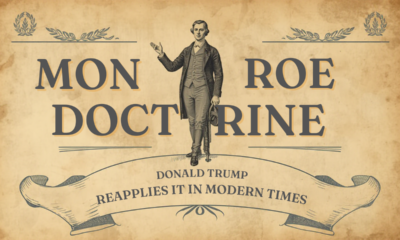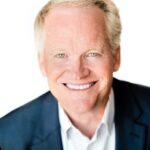Executive
J.D. Vance’s Promise: Economic Mobility and Wealth Creation
The key to economic mobility is not redistribution of wealth but its creation. Herewith recommendations for policies that create wealth.

The election of J.D. Vance to the vice presidency could usher in a once-in-a-lifetime opportunity for dramatic advancements in the lives of America’s most down-trodden, forgotten, and trapped: Such is his promise “to never forget where he came from.” With the right policies, programs, and commitments, his compelling personal story of triumph over a broken home, the ravages of drug addiction, poverty, and cultural isolation could be replicated among millions.
One of the opportunities for transformative progress in a Trump-Vance administration lies in the fields of economic mobility and wealth creation. Coupled with new approaches to substance abuse and education – topics covered in the first two essays in this three-part series – President Trump and Vice President Vance could help reverse decades of growing wealth inequality between America’s most privileged and least fortunate. Market-oriented changes in three specific areas – homeownership, retirement savings, and employee stock ownership plans – would help end decades of growing inequality not by redistributing existing wealth but by giving historically excluded Americans proven tools for improving their financial well-being all on their own.
The state of wealth disparity today
Wealth disparity in the United States is now roughly equivalent to Russia’s – a damning comparison – and much higher than averages in most industrialized nations. Extreme wealth disparity strains social cohesion and undermines public faith in institutions by breeding perceptions of unfairness.
Americans are also growing more unequal in wealth. In 1963, the wealthiest American families had 36 times the wealth of families in the middle distribution; by 2022, this disparity had doubled to 71 times as much.
U.S. wealth inequality has overwhelming racial correlations. According to research by the St. Louis Federal Reserve Bank, African American families today have 23 cents for every dollar of white family wealth, and Hispanic families have only 19 cents. These gaps have also grown larger over time.
Homeownership – first step toward wealth creation
In our country, homeownership is the primary way citizens build wealth. In 2018, the black-white homeownership gap reached its highest level in 50 years. Today, black Americans remain the only racial group with a homeownership rate below 50%. If we want to narrow the wealth inequality gap between races, black and Hispanic homeownership must increase.
Improving home affordability, access to credit, helping people remain in their homes, and changing cultural mindsets are all needed for growing disparities in American homeownership to change. Reforming local land-use and zoning policies, deploying more public-private partnership resources to expand the supply of affordable for-sale housing, increasing down-payment assistance, and educating the broader public on ownership-vs-renting benefits are all part of the solution.
Homeownership could also be dramatically increased by unlocking appreciating home equity for first-time home buyers, enabling them to come up with a down payment and lower mortgage debt. Capital for these shared appreciation loans could come from institutional investors on a pro-rata basis. Home equity is America’s second-largest asset class at $31 trillion, but it largely sits untapped. As an asset class, home equity generates attractive, diversified, low-risk, positive inflation-adjusted returns. Policy initiatives and regulatory changes designed to unlock this appreciating asset class to the direct benefit of first-time and existing homeowners present a scalable solution for millions of people who have been left out of the housing market.
From homeownership to retirement savings
Expanding home ownership in lower-income, racially segregated communities would have significant ancillary benefits beyond wealth generation. Children of home-owning parents have greater educational attainment and income mobility than children of renters. This difference is especially stark among low-income families. Homeownership feeds directly into improved health, educational, and career outcomes, all vital components of family well-being.
Americans have consistently built wealth in two other ways beyond homeownership: First, by staying invested in the stock market over long periods of time; and second, by sharing in the wealth creation process of individual businesses. Basic market-friendly changes in retirement savings programs and more support for employee stock ownership plans would present two additional policy priorities for a Trump-Vance administration.
Today, 70 million hard-working Americans aren’t offered any retirement benefits through their place of employment. Among the bottom 50% of America’s wealth holders, the median retirement savings account balance is $0. For the most part, tax policies regarding retirement savings hinge on granting tax benefits through deductions, as opposed to credits or direct matches. This deduction approach is regressive because those with the highest incomes and the highest marginal tax rate gain the most.
A Thrift Savings Plan for non-federal employees
The simplest and most tax-efficient way to help lower-income Americans save for their retirement is to give them the exact same benefit provided to every U.S. federal employee: access to the wealth-building vehicle known as the Thrift Savings Plan. The federal Thrift Savings Plan has a multi-decade history with 6.5 million federal employees who voluntarily set aside portions of their pay to invest in a range of target date and multi-asset funds.
Such funds ensure that beneficiaries have high equity exposures when they are young and higher bond exposures as they age, ensuring greater predictability in retirement income. The plan’s common stock index fund has returned 10.83% per year since its inception 35 years ago, meaning its holders have, on average, doubled their retirement savings every 6½ years. The Retirement Savings for Americans Act – bipartisan legislation that uses the same model as the Thrift Savings Plan – would similarly provide a path to more secure retirement for tens of millions of hardworking Americans. A supplemental retirement market reform sponsored by a Trump-Vance administration could augment retirement savings among lower-income groups by partially funding such accounts at birth, something the state of Connecticut has started to do with its CT Baby Bonds program.
Employee Stock Ownership
Some 32 million American workers are employed by 2.9 million privately held firms owned by individuals at or near retirement age. A final, market-friendly policy the Trump-Vance administration could embrace involves creating employee stock ownership plans (ESOP). Here, bipartisan legislation has already been proposed in the Senate. The Employee Equity Investment Act would create a public-private partnership vehicle that facilitates the sale of privately-held companies to their employees – allowing them to maintain their jobs and build more wealth for themselves in the future. According to Jack Moriarty of the Lafayette Square Institute, such a program would build “a more competitive, resilient and broadly prosperous American economy.” ESOP participants have more than twice the average retirement balances of other Americans, proof of their effectiveness in building and retaining personal wealth over decades.
Transformational policy changes require vision, strong White House leadership, and a proven willingness to work across political lines. In areas as diverse as homeownership, retirement savings, and employee stock ownership, the time is ripe for generational reform. By providing heightened focus to proven methods for enhancing economic mobility and wealth creation – along with substance abuse and education – J.D. Vance, working side-by-side with Donald Trump, could improve the lives of millions of Americans. Such would be the promise of “remembering where he came from.” And such would be the promise of reinvigorating and restoring the American Dream.
See also
Part one: Addressing Substance Abuse (see also here)
Part two: Bolstering Education (see also here)
This article was originally published by RealClearPolitics and made available via RealClearWire.
-

 Civilization4 days ago
Civilization4 days agoTrump’s Venezuela Gamble and America’s Shifting National Security Strategy
-

 Civilization4 days ago
Civilization4 days agoOperation Absolute Resolve: Anatomy of a Modern Decapitation Strike
-

 Civilization4 days ago
Civilization4 days agoTen Reasons To Cheer the Arrest of Maduro
-

 Civilization2 days ago
Civilization2 days agoOne Fell Swoop: Lawsuit Eyes Death Blow to Racial Preferences
-

 Civilization23 hours ago
Civilization23 hours agoTrump’s New Doctrine of Precision Deterrence
-

 Executive2 days ago
Executive2 days agoWaste of the Day: $1.6T in Wasteful Spending in Rand Paul’s “Festivus” Report
-

 Guest Columns3 days ago
Guest Columns3 days agoAdvice to Democrats Regarding Maduro Arrest: Resist Reflexive Opposition
-

 Civilization10 hours ago
Civilization10 hours agoTrump’s version of the Monroe Doctrine















